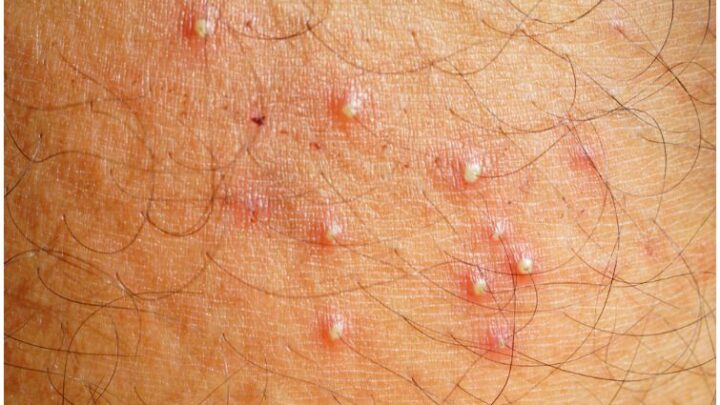Ingrown hair and staph infection: Symptoms, causes, treatment

This can make you more likely to get ingrown hairs, especially after shaving. If your infection is mild or infrequent, you may be able to use home remedies. If infections recur or are severe, you may need medical treatment. Ingrown hairs are most common in areas of hair removal, such as the face, legs, armpits, and pubic region. They also occur more often in men who shave their beards. Shaving and waxing creates sharper hairs that tend to get trapped in the skin.
How can I prevent a staph infection?
This is when the boils are clustered together to form an area of infection. Cases of folliculitis barbae may occur secondary to viral, mycologic, or eosinophilic causes, and may be seen in competitive athletes and immunosuppressed persons. People who have a long history of topical antibiotic use can discuss alternative treatment options with their doctors. Doctors can treat severe folliculitis with a prescription-strength antifungal or antibiotic ointment.
Conditions
5 Belly Button Infections You Can Get (and What to Do If You Have One) SELF - Self
5 Belly Button Infections You Can Get (and What to Do If You Have One) SELF.
Posted: Sat, 23 Feb 2019 08:00:00 GMT [source]
Treat a stye by using warm compresses over the eye (with the eye closed) three or four times a day. Curlier and coarser hairs of persons with darker skin types (such as African Americans) are more likely to penetrate perifollicular epidermis, causing PFB. Some people develop mild folliculitis in areas subjected to moisture and friction, such as areas under sports equipment or on the buttocks. They may take a swab of the infected skin to test for which bacteria or fungus is the cause of the folliculitis. The answers to these questions often confirm a diagnosis of folliculitis and help your provider determine which type it might be.
Complications
However, each person may experience symptoms differently. A skin abscess may go away on its own, and warm compresses may speed up the process. Otherwise, a doctor treats an abscess by cutting it open and draining the pus.
How is folliculitis barbae diagnosed?
An infected ingrown hair happens when a hair is blocked from leaving the skin or newly emerged hair curls back into the skin, and the follicle becomes infected. Bacteria from the boil can spread to other parts of your body or enter your bloodstream. If this occurs, your heart, bones, brain or other organs could be at risk for infection. Antibiotics are used to treat certain boils that develop near the vagina. Your healthcare provider will determine if an antibiotic is necessary or if at-home treatment will resolve the issue. A boil can develop on the labia (lips of the vagina), in the pubic region (where pubic hair grows) or in the vulvar area around your vagina.

They may wish to speak to a doctor, who can help manage their condition and prevent scalp folliculitis. Eosinophilic folliculitis causes deep-set, pus-filled skin lesions to occur mostly on the face, neck, and scalp. This form of folliculitis affects infants and people with weakened immune systems.
Everything you need to know about folliculitis

People at higher risk should take care to wash their hands thoroughly and regularly and to sterilize shared surfaces whenever possible. They may also wish to avoid sharing personal items, such as towels, washcloths, and sports equipment. In some cases, if the diagnosis is uncertain or if there is a need to rule out other conditions, a biopsy may be performed. A small sample of the affected skin is taken and examined under a microscope to determine the cause of the problem. Staph infections are highly contagious and can be spread through direct contact with infected individuals or by touching contaminated objects or surfaces.
A staph infection is caused by the staphylococcus bacteria, while an ingrown hair occurs when a hair curls back or grows sideways into the skin. Preventing staph infections and ingrown hairs begins with practicing good hygiene. If you suspect an ingrown hair or staph infection, it is important to seek medical attention to prevent complications and ensure proper treatment. An ingrown hair occurs when a hair grows back into the skin instead of rising above the surface.
When they do, they create many thousands of serious cases of S. Razor bumps that emerge after shaving, known as pseudofolliculitis barbae, can become pustules, papules, or cysts resulting from ingrown hairs. While some cases resolve on their own, there is a possibility of infection, which requires treatment. This can lead to inflammation, redness, irritation, and the formation of tiny, irritated, and painful bumps. Ingrown hairs commonly occur in areas where hair is frequently removed, such as the face, neck, armpits, legs, and groin area. PFB presents more frequently in post-shaven hair-bearing areas of persons with more curly and coarse hair, as seen in African Americans.
If they suspect staph, they will seek to begin treatment quickly to avoid further illness. Staph bacteria can spread to a person through skin-to-skin contact with someone with the infection. Therefore, the best way to avoid a staph infection is by practicing good hygiene. Proper hygiene practices are particularly important in areas where people congregate, such as public pools, schools, gyms, and residential facilities.
Folliculitis due to ingrown hairs usually improves when a person stops shaving for up to 1 week. Antibiotic-resistant strains of staph bacteria are often described as methicillin-resistant Staphylococcus aureus (MRSA) strains. The increase in antibiotic-resistant strains has led to the use of IV antibiotics, such as vancomycin or daptomycin, with the potential for more side effects.
Comments
Post a Comment